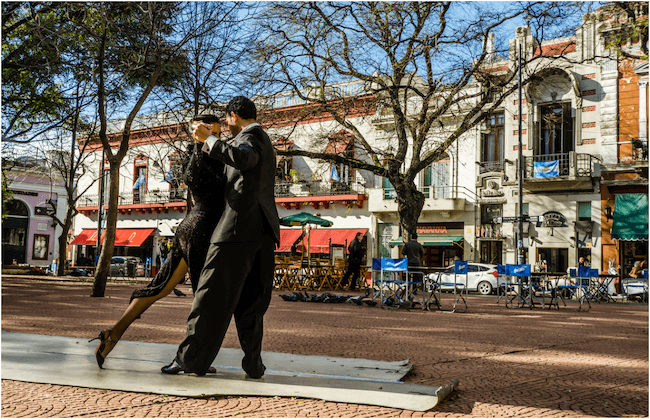Tango – it takes two baby!
Sensual, intense and dramatic, the tango is Argentina’s best-known export. A distinctive art form, the tango is recognised worldwide as the definitive Argentinian dance (though Uruguay lays claim to it too!).
With intense eye contact and complex and intricate footwork (goodness knows how the women manage it in those heels!), the tango evolved among the working classes living around the Rio de la Plata in Buenos Aires and Montevideo between 1850 and 1910.
These areas were melting pots of cultural influences from descendents of African slaves, Creoles, European immigrants from Spain, Italy and other countries, and the gauchos (a kind of tough and unruly Latin American cowboy culture).

Milongas – the tango social
The tango is a very social dance. Tango social events called milongas are held for aficionados of different levels to meet others and dance. Milongas are plentiful in Argentina, Latin America, North America and Europe, and as the popularity of the artform has spread around the world, so too have milongas. So it’s easy to find places and people to dance with no matter where you are in the world, from Beijing to Berln, or Melbourne to Mozambique. And Paris of course.
Folk dances
While Argentina is known for the tango more than anything else, the country also has a long list of traditional folk dances most people haven’t heard of. Many of these dances evolved long before the tango with the indigenous communities. And they are nothing like tango at all.
Carnavalito – upbeat old-world dance
The Carnavalito for instance is a hilarious high-energy group dance with pairs frantically jiggling their heads and jumping in unison. With arms linked the dance is performed in serpentine rounds in a circular motion. It is an old-world dance that was common before the arrival of the Spanish conquistadors, danced by the indigenous Quechua population. It’s a frenetic dance requiring vigorous movements and a must-see for any visitor to the north of the country.
Malambo – an Argentinian dance for men
The malambo is a dance of men. Performed to a drum beat played on a bombo legúero (a traditional animal skin drum) and guitars – no vocals –, it evolved from the gaucho culture. It features synchronised energetic footwork that can look a little like flamenco with whips, or sometimes like a cross between Irish dance and tap dance performed by dandy cowboys in heels and puffy pants – though very much still a bald display of masculinity.
Some contemporary performance groups have dropped the traditional malambo garb in favour of a sexier look such as tight black leather pants and open shirt (keeping the heels) which has given the dance more widespread appeal. Done well, it can be very impressive (Simon Cowell thought so when Malambo group Malevo performed on America’s Got Talent in 2016). Occasionally girls can be seen performing the malambo in local town groups though it’s unusual.
La Murga – the carnival dance
La Murga is a Carnival street parade performance – an in-your-face theatrical art form combining music and dance. Performers wear bright elaborate costumes, and sing and dance with loud whistles, percussion, symbols and sparkle. They perform joyful dance moves in rough formations with lots of jumping around in more or less synchronous formations often with incredible energy and agility.
The murga evolved from a coming together of European and African influences. It was started by a group of gaditanos (Spaniards from Cadiz) who performed in hotels with no crowd success so they decided to take their act to the streets where it became hugely popular. With increasing popular participation, it evolved into the carnival parade groups of today. The murga is often linked with social and political commentary, and to the spirit of protest and freedom. Groups often incorporate well-known songs and change the lyrics to suit their show.
Chacarera – Argentinian folk dance
The Chacarera is a joyful folk dance that was born in Argentina. It is danced in pairs in the open position (not touching or holding your partner’s hands or waist) with arms raised and outstretched, fingers clicking. With the arms held high the couple perform intricate foot work, while maintaining eye contact and performing their graceful movements in a circular motion.
Zamba – a dance of seduction
The Zamba is an interesting picaresque dance performed in pairs. The couple, in open position, use handkerchiefs to send messages to each other while they dance. It’s a fun, elegant dance, also performed in circular movements with lyrics of romance and love. The couples hold high and twirl their handkerchiefs while facing each other and dance with varying rhythms around an imaginary circle. It is a love dance that simulates a wooing and capitulation and ends with a simulated kiss – so brush your teeth.
These are just a few examples of traditional Argentinian dances, but there are many more – la cueca, el cuarteto, el chamame, la cumbia, among others. Argentina is also a great place to dance other Latin dance styles such as Salsa and Bachata with lots of local clubs offering the chance to learn and dance. And for tango learners and dancers, attending a milonga is a not just a great way to experience this iconic dance, it’s an amazing immersive experience of local culture.
No comments yet
There are no comments on this post yet.




Leave a comment